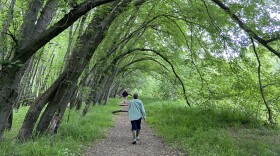Something Wild co-host Dave Anderson of the Forest Society has been enjoying his birdfeeders and considering the benefits.
“Every morning, just before sunrise, I wait with steaming cup of coffee in hand for those first birds to arrive.
I’m the forest guy, but I’ll admit I’m a self-confessed bird feeder aficionado. Just outside my living room window, I have eight feeders: mounted on poles, suction-cupped to windows, and hanging from the low branches of a crab apple tree.
I love the daily rhythm of familiar winter birds visiting my feeders. Blue Jays, cardinals, chickadees, and woodpeckers, all coming and going, over and over. I notice slight changes from day to day and week to week.
The whole experience brings me comforting daily news from the natural world. They don’t know it, but these wild birds serve as emissaries from the surrounding forests and fields and wetlands. Watching their grace, and their antics, can be peaceful and affirming.
I’d say that people doing the feeding benefit as much as the birds do, maybe more. Watching birds at my feeders helps me gauge the passage of the winter and get clues about how spring is progressing – day length, sun’s angle, and the quality of light.
The plumage of gold finches and Cardinals begins to brighten to yellow and red at the beginning of March as spring is advancing. Bluebirds and Cardinals come to the feeders in pairs. Chickadees, nuthatches and titmice sing as well, particularly on warm late winter days.
Hanging suet cages attract the woodpeckers who drum on hardwoods in the surrounding forest. This swelling spring bird symphony often begins with a rhythm section and the tuning-up of the hardy cavity-nesting resident winter birds, what I call the “woodwinds section.”
When you feed the birds, you really feed all the birds, even the predators. Sharp-shinned hawks and barred owls are drawn to the feeders not for the seed, but for the seed-eaters, both the small birds and the mice and red squirrels.

What I get from feeding birds all winter is well worth the cost of a few 40 pound bags of black oil sunflower seeds and packaged suet cakes over the course of the winter.
But I would be lying if I did not admit that I do this – not for the birds – but entirely for myself. Watching the bird feeders each morning is a comforting ritual, an intentional excuse to slow down and reflect on life – wildlife and the beauty of Nature.”
Chris Martin, from NH Audubon and Something Wild co-host, points out that New Hampshire's overwintering birds are all well-equipped to survive the cold months without bird feeders. Most would still be close by, even without us providing seed and suet.
Are your local birds dependent on bird feeders? Are we doing them any great service by providing supplemental food during these coldest months of the year? The general consensus is no. Northern birds have evolved metabolic strategies to survive cold temperatures, and they’re well-adapted to forage for native food sources they can find in the woods.
Most winter birds spend hours gleaning chilled spiders, insect eggs, and seeds from buds, twigs, and bark crevices. Trees provide a vast landscape of surfaces that harbor all sorts of natural winter foods.
Some species, such as jays and nuthatches, take advantage of the abundance by creating winter food caches.

Many people in New Hampshire feed birds only during the cold and snowy winter months. NH Fish and Game recommends that all bird feeders be taken down by April 1 to avoid issues with bears leaving dens in early spring and looking for food.
The calories found in birdseed far exceed natural foods available to bears before leaves emerge in May. The risk of seeking meals in suburban and even urban neighborhoods is worth taking for winter-hungry bears.
The choice of feeders depends on the types of feed and the birds you hope to attract.
The most popular seed is black oil sunflower seeds or a mix of yellow millet seed mixed with sunflowers to feed a wide range of winter resident birds. The most common winter resident feeder birds typically include juncos, chickadees, titmice, nuthatches, gold finches, cardinals and blue jays.
Hanging suet cages designed to hold beef suet cakes attract several species of woodpeckers: Downy woodpeckers, Hairy woodpeckers and Red-bellied woodpeckers. The large pileated woodpeckers generally feed on carpenter ants but occasionally visit feeding stations. Winter songbirds at suet feeders can include wintering bluebirds.
Other specialized feeders are designed for feeding small Nigerseed or Thistle seed that are favored by winter finches: gold finches, purple finches and pine siskins.
For more information on New Hampshire birds, check out NH Aububon. Their Ask the Naturalist feature answers many questions about birds.
Here are 11 tips to attract the most feathered friends to your feeders.
The National Wildlife Federation recommends thinking of gardening with native plants as part of feeding birds.
Birdsong is good for your mental health!
Something Wild is a partnership of the Forest Society, NH Audubon, and NHPR.












